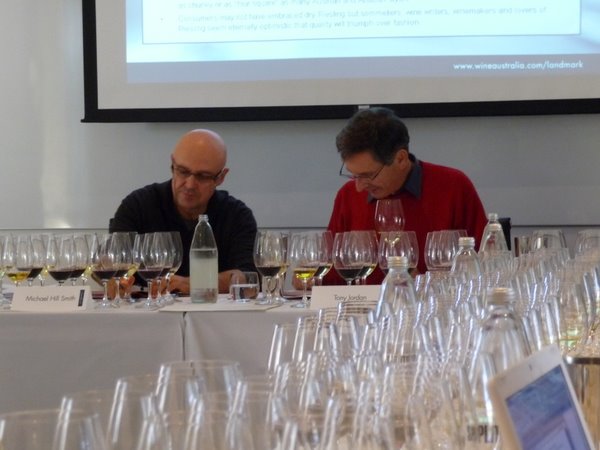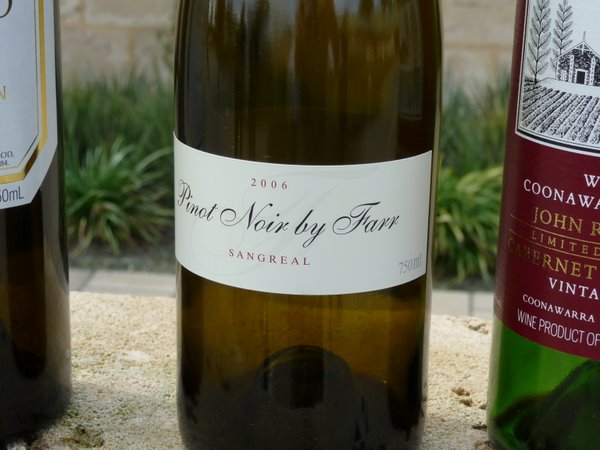|
Session
1: Australia's regional classics
Landmark Australia
Tutorial
Website:
www.landmark-wineaustralia.com
Michael Hill
Smith described the tutorial as ‘like an immersion language
course,’ as he kicked off the first session, which was an
introduction to Australia’s regionality. Of late, the Australian
wine industry has put a lot of effort into helping people appreciate
the extent of the regional differences that exist in this country,
and which are important in shaping the diverse wines it produces.
‘Australia is
regional,’ Hill-Smith stated. ‘It’s not a question of someone
making it up: we have 64 GIs [geographical indications, the official
term for wine regions] across the depth and breadth of Australia.’
Regionality in
Australia began with the establishment of the colonies in the 19th
century. Settlers brought with them grapevines and, as Tony Jordan
pointed out, they planted them in what turned out rather
fortuitously to be fairly useful viticultural regions. Adelaide
enjoys a nice Mediterranean climate, for example, and Melbourne is
just a little cooler. It is only since the 1970s that science has
been enlisted in prospecting for new viticultural areas, such as
Margaret River, Tasmania and Great Southern.

Two of the tutors conferring: Michael Hill Smith and Tony Jordan
The viticultural
areas are largely located in the south. Australia is a vast country,
and most of it is unsuited to viticulture, but even so, the current
vineyards occupy just 2% of the land where they could potentially be
planted. Water is one of the limiting factors hindering further
development, but there is still plenty of room for expansion. The
factors influencing temperature include latitude, altitude (lapse
rate of 0.65 °C for each 100 m shift) and the prevailing weather
patterns. Significantly, cyclonic weather patterns come off the cold
Southern Ocean and move from west to east, and have a cooling
effect.
One of the
difficulties in getting to grips with Australian regionality is that
winemaking style can imprints itself over the regional style. Not
not all Barossa wines taste like they come from the Barossa, and not
all McLaren Vale wines taste like McLaren Vale, and so on. But this
is a problem encountered across the wine world: the influence of
site can be lost through heavy-handed winemaking styles, or picking
late. In fact, it’s probably true to say that regional
characteristics in a wine are the result of a combination of site
and the human element – including both viticultural and winemaking
practice.
So, what was the
point of this initial tasting? It was to introduce some of Australia’s
regional classics. In each region, one or two grape varieties tend
to produce great wines. For example, Coonawarra makes OK Sauvignon
Blanc, OK Riesling and OK Shiraz. But it makes fabulous Cabernet
Sauvignon. So regional classics are the wines where region
and grape combine to make something really special. These wines were
chosen to be examples of some of these, and to set the scene for a
more in-depth exploration of Australia’s fine wine dimension in
the subsequent sessions.

One of the wines of this first tasting
2008 Grosset
Wines Polish Hill Riesling, Clare Valley
Handpicked, destemmed and just the free-run juice used,
fermented at 14–17 °C. Taut, fresh, mineralic nose is limey and
precise. The palate is intense and dry with a lean, high-acid,
lemony character. Great concentration and precision here, tending
towards the austere with this limey character to the fore. A
striking wine. 92/100
2002 Pewsey
Vale The Contours Riesling, Eden Valley
From a cool vintage. Really intense, taut and mineralic, with a
limey, slightly toasty nose. Showing some nice evolution. The palate
is concentrated and intense with spicy, limey, mineralic fruit and
real intensity. Very dry with savoury complexity and good acidity.
Lovely. 92/100
1998 Tyrrell's
Wines Vat 1 Semillon, Hunter
Toasty, citrussy and quite intense on the nose. Just beginning
to evolve. The palate is savoury and lemony with high acidity and
the first signs of the broader, more toasty notes emerging. Finishes
tight and quite intense, with a long future ahead of it. Just 10.8%
alcohol. 91/100
2005 Leeuwin
Estate Art Series Chardonnay, Margaret River
Made with skin contant and no solids in the fermentation (these
can add more savoury characters). Rich, complex, broad and toasty on
the nose with some nutty notes. The palate shows coconut, pineapple
and peach notes as well as breadth and elegance, despite the size.
Complex and long. 93/100
2006 Petaluma
Piccadilly Valley Chardonnay, Adelaide Hills
Fresh and focused with some nutty, toasty notes. A lighter style
with some elegance and a lemony edge to the fruit. Nice oak use.
Light and quite elegant with a subtle toastiness. 89/100
2006 By Farr
Sangreal Pinot Noir, Geelong
Wonderful aromatics: sweet herbs, cherries and spice. Complex
and warm with some meaty hints. The palate shows fresh, pure cherry
and spice notes with lovely focus and some hints of meat and earth.
Wonderful stuff: big but expressive, and truly complex. 94/100
2001 Cullen
Wines Diana Madeline Cabernet Sauvignon/Merlot, Margaret River
Sweet dark chocolate, earth and spice notes on the nose, with
gravelliness and also some earthy blackcurrant fruit (blackcurrant
bud). The palate is fresh and dense with lovely taut earthy
structure, nice spiciness and focused dark fruits. With freshness
and complexity, this is ageing really nicely. 94/100
2004 Wynns
Coonawarra Estate John Riddoch, Cabernet Sauvignon, Coonawarra Subtle
green edge to the fresh blackcurrant fruit nose, but also some
appealing creamy richness. The palate shows great concentration of
sweet, pure blackcurrant fruit with a spicy edge. Lovely definition
here. A beautiful, pure, balanced Cabernet. 93/100
1998
Brokenwood Graveyard Vineyard Shiraz, Hunter
Evolved nose showing beautifully floral, earthy, spicy notes and
a hint of medicine. The palate is broad, warm, earthy and spicy with
lovely earthiness and a touch of iodine. Just lovely, with real
complexity and some elegance. Apparently this isn’t as fresh as
this wine typically shows. 93/100
2004 Mt Langi
Ghiran Langi Shiraz, Grampians
Lovely pure, fresh, focused dark fruits on the nose with some
fresh black pepper in the background. The palate has lovely
freshness and precision with a delicious peppery edge. Sweet, pure
fruit, yet some elegance, too. 94/100
2006
Henschke Mt Edelstone Shiraz, Eden Valley
From vines planted in 1912. Rich chocolatey, spicy nose. Quite
ripe. The palate has a ginger spice edge to it with focused
sweet red and black fruits. A bit lighter than the normal Barossa
style, with a warm spicy finish and some plummy characters. 92/100
2004 Penfolds
RWT Shiraz, Barossa Valley
Ripe and rich with bold, sweet, focused blackberry and plum
fruit. Nice density with lovely focused fruit and good structure. I
like the cherry and plum fruit characters on the palate: it’s
quite a big wine, but expressive with it. 93/100
2006 Glaetzer
Anaperenna Shiraz/Cabernet Sauvignon, Barossa Valley
Lush, pure and super-sweet with blackberry and cherry fruit.
Lush, smooth and intense with soft structure and good definition,
finishing spicy. A little unusual but really good. 93/100
2006 De
Bortoli Noble One Botrytis Semillon, Riverina
Very fresh apricot and spice nose with some lemony notes.
Powerful, intense, lush palate is viscous and shows lovely spiciness
and ripe peach, pear, melon and apricot fruit. 92/100
Landmark
Australia
 Introduction Introduction
 Visiting
the Australian Wine Research Institute Visiting
the Australian Wine Research Institute
 Session
1 - Regional Classics Session
1 - Regional Classics
 Session
2 - Riesling Session
2 - Riesling
 Session
3 - Shiraz and Blends Session
3 - Shiraz and Blends
 Session
4 - Historical Perspective Session
4 - Historical Perspective
 Session
5 - Semillon, Sauvignon Blanc and Blends Session
5 - Semillon, Sauvignon Blanc and Blends
 Session
6 - Cabernet Sauvignon and Blends Session
6 - Cabernet Sauvignon and Blends
 Session
7 - An Alternative View Session
7 - An Alternative View
 Session
8 - Chardonnay Session
8 - Chardonnay
 Session
9 - Pinot Noir Session
9 - Pinot Noir
 Session
10 - Blending the rules Session
10 - Blending the rules
 Session
11 - Sparkling Session
11 - Sparkling
 Session
12 - Fortified Session
12 - Fortified
Wines
tasted 06/09
Find these wines with wine-searcher.com
Back
to top
|